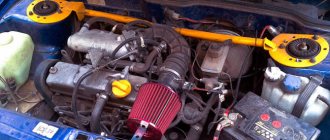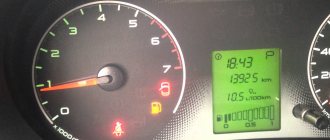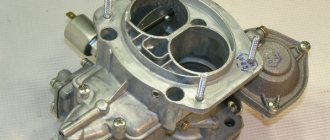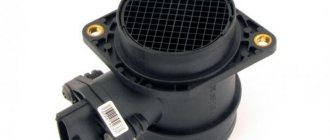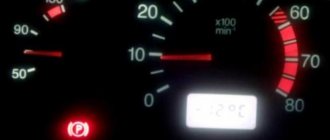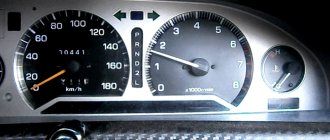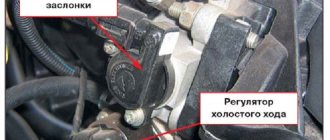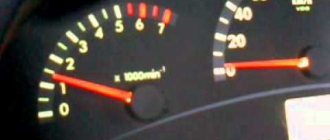In fact, there are many reasons why the speed of a VAZ-2109 car noticeably fluctuates. This problem manifests itself to a lesser extent on those vehicles whose engines have an injector, and to a greater extent on carburetor models.
In this article we will try to talk about the most common breakdowns that have a similar symptom.
Why do the revs fluctuate on the VAZ 2109 injector?
Another question that worries many VAZ 2109 owners: why does the engine speed fluctuate at idle? There can be no single answer, as for many other questions. But you can give some recommendations and tips to find and fix these problems.
On carburetor VAZ 2109 models, in most cases the cause is either a malfunction of the carburetor and its incorrect adjustment, or an incorrectly set ignition (most likely later).
As for injection engines, there may be many more reasons, since the ECM system is quite capacious and complex. Let's look at some of the many:
- IAC malfunction. Idle speed regulator - it is this “sensor” that is responsible for the stable operation of the engine’s idle speed. And if the stability of operation is impaired, then there is a high probability that it is the IAC that is the cause of this disaster.
- Failure of the throttle position sensor is also not uncommon. By the way, floating speed can also easily be the cause.
- DMRV is faulty. To understand how much the mass air flow sensor influences floating speed, check out the video below, which clearly shows an example of a “broken” mass air flow sensor.
- Air leak in the power system. This is especially true for the injector inlet pipe, which runs from the air filter to the throttle assembly. If a loose clamp or a rupture of a hose or pipe is detected, this problem must be urgently corrected.
- Malfunction in the ignition system. There can actually be many reasons here, from spark plugs and wires to ignition coils. Even a banal large gap on the spark plugs can cause the speed to fluctuate.
- Failure or uneven operation of one of the injector nozzles. Injectors can become clogged from time to time because the fuel cleanliness is not ideal. And the cause of uneven fuel supply can be a clogged injector. Which entails floating revolutions, as a consequence.
Operating principle
When the car is moving and the throttle valve is open, the IAC is not involved in the process, its valve is closed and the rod is motionless. When the damper closes and the engine goes into idle mode, voltage is applied to the electric motor and the rod moves towards the opening - the valve comes into operation. It opens slightly, and air enters the engine bypassing through a special hole.
When the driver turns on the ignition, the IAC rod fully extends to its extreme position and closes the calibration hole in the throttle pipe. The sensor then counts the steps and the valve returns to its home position. As for this basic position, it can be different and depends on the firmware installed in the ECU. For January 5.1 firmware the position is 120 steps, for Bosch firmware it is 50 steps.
Speed floats with a faulty mass air flow sensor on an injection engine
As you can see, from the video review it is clearly visible that the symptoms can be quite sad and in addition to the floating idle, there are many negative consequences from such a malfunction.
If you have anything to add to this article, write in the comments and discuss it together!
This problem is often talked about a lot, both on forums and in print publications for car enthusiasts. Idling speed of the VAZ 2109 (carburetor) is a whole story. And, unfortunately, not always with a good ending.
Location
Knowing the principle of operation of the VAZ-2109 idle speed sensor (injector), it is not difficult to guess where it should be installed. On this vehicle it is located near the throttle valve and throttle position sensor. The device is fixed with screws on the damper body. In case of failure, the car owner can easily replace it himself.
If the idle speed of a VAZ 2109 (carburetor) fluctuates?
The first thing that the owner of a VAZ 2109 car who is faced with such a problem should know is that the carburetor itself is not always to blame. It may turn out that the ignition system or power system is faulty. Problems usually start when the car is warm. And here the reasons are the same for Ozone, Solex and others.
Let's start with the main known symptoms of this idle problem.
- VAZ 2109 carburetor idle speed floats;
- individual popping sounds are heard in the muffler or carburetor;
- there are gaps during operation of the engine cylinders;
- The speed changes, sometimes up, sometimes down.
Causes of the “disease” and ways to eliminate them:
- Firstly, the problem may be due to the fact that the VAZ 2109 carburetor was adjusted incorrectly. Usually - towards a leaner combustible mixture. This misunderstanding can be eliminated simply - with the help of “quality” and “quantity” screws. This has already been discussed in the article adjusting the VAZ 2109 carburetor.
- The second common cause is a faulty solenoid valve. If the valve is faulty, the flow of fuel into the idle system is blocked. If, while the engine is running, you quickly remove and put the wire back on the valve, you should hear a click. This indicates that the valve is in working order. If this is not the case (there was a click), then we check the forced idle economizer system itself.
- The third problem is dirt getting into the jets and channels in the idle system. They can be blown out under pressure by first placing a certain amount of cleaner in the valve hole.
- If you have checked all these options, but your VAZ 2109 (carburetor) still idles, then you need to check whether the VAZ 2109 (carburetor) air filter is clogged.
Signs of malfunctions
It should be noted that it is difficult to successfully resolve this situation without making the correct “diagnosis”. It is important to check all working components of the motor.
The following symptoms indicate poor carburetor performance:
- The Lada engine speed drops on its own, resulting in an unreasonable increase.
- There are gaps in the functioning of the cylinders.
- In the area of the carburetor and muffler, sharp pops periodically occur.
- At idle, the number of rotations is unstable, they have fallen.
Let's list them.
- The most basic is a malfunction or failure of the mass air flow sensor.
- No less common is the breakdown of the idle air control valve.
- A crankshaft position sensor providing incorrect information to the control unit can also be the root cause of a high or floating idle.
- The throttle position sensor may also be to blame.
- It happens that for some reason the gas pedal does not return all the way back. Moreover, this happens both because of a banal malfunction of the cable, and because of something completely ridiculous - for example, after washing the car, they covered the driver’s mat in such a way that the tip of the mat began to touch the pedal.
- The air filter is very clogged. Because of this, the combustion mixture is too rich in gasoline, again resulting in high idle speeds.
- The cable came off the throttle valve.
- Engine temperature sensor faulty. It gives the car’s “brains” incorrect values, which increase the crankshaft speed, thinking that the engine is cold.
As you can see, we have before us a whole forest of very different reasons why high revs appear! Next, we will take a closer look at the most typical, plus the most common problems associated with the problem described. At the same time, we’ll figure out how to eliminate them with our own hands.
Ways to eliminate the “sore”
If such a problem occurs, you need to look for which node is to blame analytically, checking all the specified sensors
First, let's consider the following option for correcting the problem situation. Let's assume that a VAZ 2110 has high revs. An examination of the suspected components for faulty components showed that the throttle position sensor has traces of rust. It is located directly above the throttle valve. Measurements with a voltmeter showed that when the engine is idling, the voltage on it remains high - which means it does not close the damper.
How to fix the problem? For this we only need a screwdriver. Let's begin the procedure.
- We fill the insides of the defective device with a penetrating anti-rust aerosol.
- Use a development screwdriver to turn the wheel.
- We reassemble in reverse order.
Check to see if the engine idle speed is now high. The problem should go away.
Now let's look at another case. Let's say we have high idle speed in a VAZ 2114. This is what we do when faced with this situation.
When clarifying the circumstances of the problem under investigation, we always initially check the operation of the idle speed sensor. This device consists of a needle built inside an electromagnetic coil. The needle either moves inside the coil, moving away from the hole in the throttle pipe, or moves out, closing this hole, thereby stopping the supply of air for combustion of the mixture.
This element is located at the throttle valve, opposite the gas pedal cable. To diagnose it, we pull out the terminal block from it, start the car, after which we see that we still have high engine speeds that have not changed at idle. Then we remove this defective unit, then clean it or replace it. For work we take:
- VAZ 2114 idle speed fluctuates: causes of malfunction and ways to solve the problem
Determining the quality of the spark
At this stage, you need to understand whether there is voltage on the spark plugs. To do this, just unscrew one spark plug and connect the central electrode to the high-voltage wire. Next, ensure that the threads are in contact with the ground of the car and turn on the ignition. A stable spark of blue (white-blue) color indicates that everything is fine with the ignition.
Check the remaining spark plugs in the same way. Because a common reason for an engine to fail to start is the failure of one of these parts.
After working for a while in this mode, the engine will stall.
Cylinders with non-functioning spark plugs are simply filled with too much gasoline and the situation will repeat itself when the engine is restarted. If there is a spark on all spark plugs, evaluate their color and size. Yellow/red color and small size also indicate that the car will start and subsequently stop working.
At this stage it is enough to replace the failed spark plugs
When purchasing parts, pay attention to the manufacturer’s recommendations regarding clearance and heat rating parameters
Injector
Most often, a drop in speed is observed at idle, but sometimes it also happens while driving.
First of all, you should pay attention (if the engine stalls or functions unstably) to the performance of the sensors responsible for:
- air intake position (air damper);
- mass air flow.
It is worth knowing that the engine circuit on the VAZ model under consideration is designed in such a way that each of the above-mentioned monitoring devices is capable of replacing the other in case of failure.
It is easy to check the functionality of the sensors. For this:
- remove the wires from the mass air flow sensor;
- get behind the wheel;
- We drive for several hours.
After this, the procedure is repeated with the air flow sensor with the mass air flow sensor turned on. Such a simple test will allow you to accurately indicate which of them has failed and, accordingly, replace the device with a new one.
In a situation where the above procedure did not help, you need to:
- dismantle and clean the XX regulator;
- treat its rod with lubricant (preferably silicone);
- check the pressure in the fuel supply system;
- replace high-voltage wires;
- install a new fuel filter;
- clean the injectors.
In most cases, this helps, in others you will need to replace (strictly following the procedure below):
- DZ sensor (throttle valve);
- XX regulator;
- ignition system coil;
- DMRV.
Air flow sensor
If the IAC turns out to be serviceable, then you should check the air flow sensor. To do this, you will also need a multimeter set to voltage measurement mode (in the range of up to 20 volts).
Measurements are carried out as follows:
To begin with, you can try to clean the sensor by blowing it with a composition for cleaning carburetors (in the form of an aerosol), although this does not always help. If after purging the voltage readings return to normal, then the “repair” was successful; if not, then the sensor will have to be replaced with a new, similar one.
Elimination of dips, jerks, and jerks in engine operation
Failure in the operation of the carburetor engine of VAZ 2108, 2109, 21099, 2101-2107, 2121 cars is one of the most common malfunctions.
Primary diagnosis of the causes of failure
Visually inspect the engine compartment of the car
We are interested in the tubes going to the carburetor that have fallen off the fittings, and the tip of the wire to the solenoid valve. Sometimes a slipped connector can permanently ruin the previously flawless operation of a car’s engine. We check how tightly the carburetor solenoid valve is screwed in or the idle system fuel jet holder plug installed instead, and we also check the tightness of the carburetor mounting nuts.
We check for a stable spark on the spark plugs and a strong stream from the fuel hose going to the carburetor
In addition, we unscrew the carburetor fuel filter plug and check its cleanliness
On cars with a contact ignition system, check the gap between the breaker contacts and their condition
Checking the operation of the carburetor accelerator pump
We remove the air filter housing, rotate the throttle valve axis of the first carburetor chamber by hand and observe from above the jets of fuel coming out of the spout (spouts on 2108) of the accelerator pump nozzle. The jets must be strong, at least 1 mm in diameter, without breaks, and fall to the bottom of the mixing chamber (chambers for 2108).
We turn out the spark plugs and identify the defective
A black, flooded, corroded spark plug needs to be replaced.
Cleaning the carburetor from an aerosol can - carburetor cleaner
If it was not possible to quickly eliminate the cause of the engine failure, you will have to take a more serious approach to identifying the malfunction leading to the failure.
Identification and elimination of the causes of failure of the carburetor engine of VAZ 2108, 2109, 21099, 2101-2107, 2121 cars
We identify places where foreign air is likely to be “sucked” into the carburetor
Checking the car's electrical equipment for short circuits
Open the fuse box and look for the fuse that keeps blowing. We find out which circuit it protects and eliminate the short circuit. Let's check the operation of the voltage regulator in the generator.
Remove the top part (carburetor cover)
We unscrew the GDS air jets, the GDS fuel nozzles, and take out the emulsion tubes. On Solexes, tubes and air jets are combined into one. We clean and blow them out. We remove the accelerator pump nozzle and also blow and clean it.
Adjusting the fuel level in the carburetor float chamber
Disassembling the accelerator pump housing
We check the integrity of the diaphragm and the cleanliness of the channels.
On Solex we disassemble the housing of the power mode economizer
We check the integrity of the diaphragm and the cleanliness of the channels.
We remove the carburetor body from the intake manifold and check the cleanliness of the holes in the transition systems of both carburetor chambers
We check the operation of the pneumatic drive of the throttle valve of the second chamber of the carburetor on Ozone and the mechanism for opening the throttle valve of the second chamber on the Solex carburetor
We check the serviceability of high-voltage wires, the distributor cover, and the slider
On cars with a contactless ignition system, we check the serviceability of the switch and Hall sensor
Checking the timing valves of a car engine
The check can be carried out by measuring the compression in the engine cylinders. At the same time, you can evaluate the condition of the cylinder-piston group as a whole.
More articles on the site on malfunctions of VAZ cars
Do-it-yourself troubleshooting
Diagnostics of mass air flow sensor and IAC
The mass air flow sensor and idle air control act as regulators of air supply to the combustion chamber.
Failure of these sensors will lead to an increase in fuel consumption, and a broken rod will affect the speedometer needle; it will remain motionless until the problem is fixed.
Diagnosis of DPCV
Crankshaft rotation sensor location
Failure of the crankshaft position sensor will negatively affect the operation of the engine as a whole. A failure in synchronization between the engine and the injection system will result in the car not starting. You can accurately determine the condition of the sensor only by using a multimeter.
To do this you need to do the following:
- Set the position on the sensor with a maximum value of 200mV;
- Connect the multimeter and close the core with a screwdriver;
Checking DPKV with a multimeter
Video about checking the crankshaft rotation sensor
Lambda probe diagnostics
Location of the oxygen sensor (lambda probe)
The sensor reads the amount of oxygen in the exhaust gases and sends a signal to the computer to increase or decrease the air supply to the combustion chamber. Diagnostics is performed with a multimeter on a warm engine. The procedure is as follows:
- One core of the device clings to the ground, the second to the output from the sensor;
- When re-gassing the engine, the multimeter readings should be in the range from 0.2 to 0.9 V;
When checking the lambda probe, the voltage readings should be within 0.2 - 0.9V
Video about checking the lambda probe
Speed sensor diagnostics
The vehicle speed sensor is located in the gearbox. Its diagnosis is carried out by visual inspection of wires and contacts. If oxide is detected, it must be thoroughly cleaned.
Replacing the air filter and glow plugs
Air filter for VAZ-2114
Since its throughput is reduced, the engine does not have enough air in the combustion chambers. Due to this, the fuel does not burn completely, and the remaining fuel is thrown out and burns out in the exhaust pipe, which can burn out as a result.
Heavy carbon deposits on the spark plugs or any mechanical damage to the housing require their replacement.
Oil deposits on spark plugs
Checking wires
The easiest way to diagnose high-voltage wires is in the dark; to do this, just open the hood. If the wire is “broken,” a spark will be visible, striking to the side.
Visual inspection of high-voltage wires
Another reason lurking in this place is poor contact, the appearance of oxide. To do this, you need to visually evaluate the wire tips (white, blue or green coating); you need to thoroughly clean them, wash them with Wedge (WD-40), dry them and put them in place.
Checking the intake manifold
Most often, air leaks occur through the connection of the intake manifold to the cylinder block. This happens due to wear of the gasket. This is not difficult to identify. To do this, you will need regular carburetor cleaner. With the engine running, you need to spray the can on all connections and places that cause you suspicion (microcracks in the commutator body itself are also possible).
Checking the intake manifold
If the engine runs without changes, then the cause of the malfunction is not here. If the engine speed increases and the engine jerks, the manifold or intake manifold gasket should be replaced.
Cleaning the throttle valve
The throttle valve needs regular cleaning of carbon deposits.
Due to heavy carbon deposits, the throttle valve may be in an incorrect position. To fix this, you will need to remove the throttle assembly and clean it with a carburetor cleaner or carburetor cleaner, and then reinstall it.
Floating speed is a standard disease of injection engines. The fact is that the ECU, when receiving an incorrect signal from a non-working sensor, mistakenly opens the air supply solenoid valve. The TPS gives a signal that this cannot happen, and the engine has already left the warm-up mode. It is at this moment that the idle speed of the VAZ-2114 begins to float. Therefore, if such a problem appears on your car, do not be upset. If the cause is detected and eliminated in a timely manner, there is nothing to worry about.
A little history
Despite the fact that the model seems old, its release was planned in March 1990, but happened a little later. In December 1990, the VAZ-21099 began to be produced in large series. The Ukrainian plant assembled this car until 2011 from Russian special vehicle kits.
The version from Ukraine had a slightly different name - ZAZ-21099. VAZ-21099 was produced under various names. They all differed in interior, details, year of production and country of assembly. Export names of VAZ-21099:
- Saloon
- Lada Samara
- Lada Sable
- Lada Sagona
- Lada Forma
- Lada Victory
All these cars had the common name “Samara”. But the VAZ-21099 had significant differences from everyone else.
- The front part of the body had long wings.
- Longer hood.
- No plastic “beak” at the front.
- New radiator grille.
- The instrument panel is gray (in other models the dominant color is brown).
This is how people of that time remember this car. But in 2004, the VAZ-21099 was completely discontinued at AvtoVAZ and replaced. Instead of the old, well-known model, the VAZ-2115 appeared. This is what made Ukrainian collectors continue to collect the legend. However, in 2011 this car was discontinued in all countries.
Together with it, they stopped producing the VAZ-21093. VAZ-21099 Victory is considered the most advanced model. Its most important advantage is that it had standard machine parameters (4x4). However, it has only a few improvements from the old model. Added.
- Rear axle gearbox from Volkswagen Golf Syncro.
- Viscous coupling.
- Angular gearbox.
- Transmission.
Victory is also distinguished by incredible dynamics, since the engine is forced. Its cross-country ability met all standards, which was perfectly possible with all-wheel drive. But times have passed, and the model has not received wide recognition. Therefore, the enterprise soon ceased its work.
Many people today prefer this car for two simple reasons.
- In terms of price, it is much cheaper than modern foreign cars, easy to maintain, and has inexpensive spare parts.
- Patriotism and the desire to preserve the legend.
But despite the fact that the reasons are compelling, and the car is of really good quality, times have taken their toll, and therefore, no matter how much one would like to admit it, the car is capable of breakdown. The carburetor is the first to suffer.
